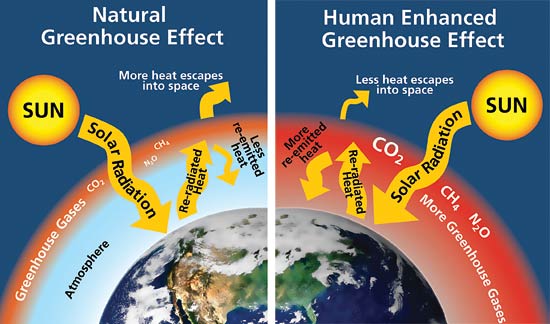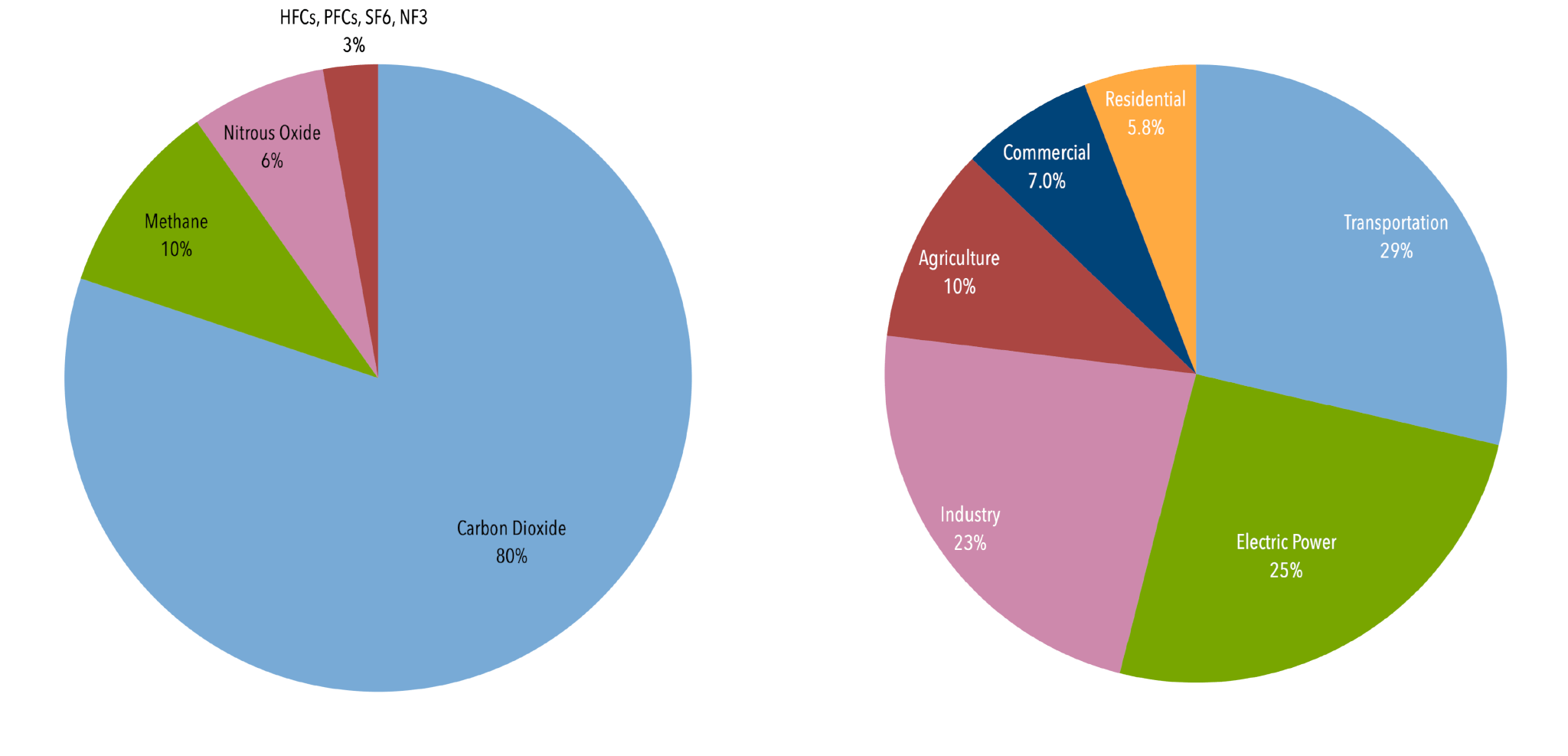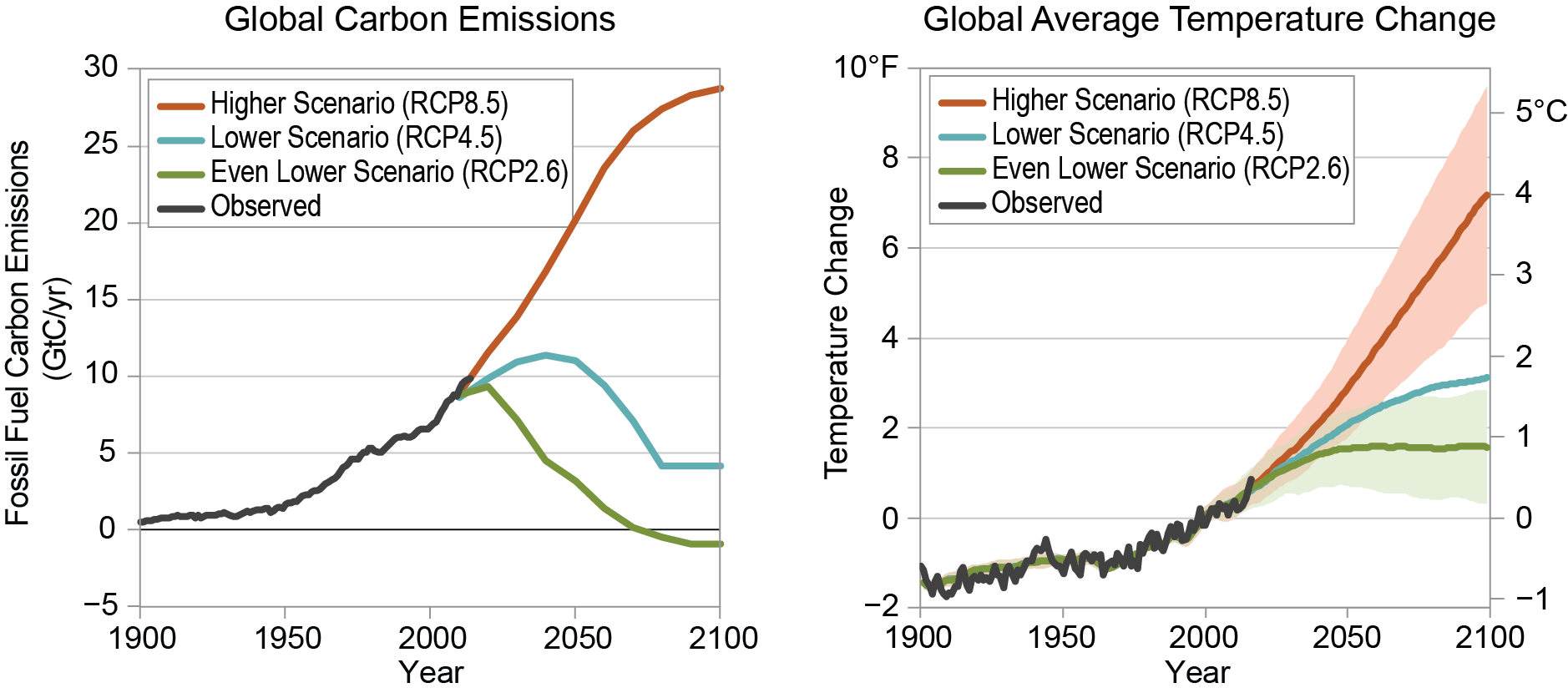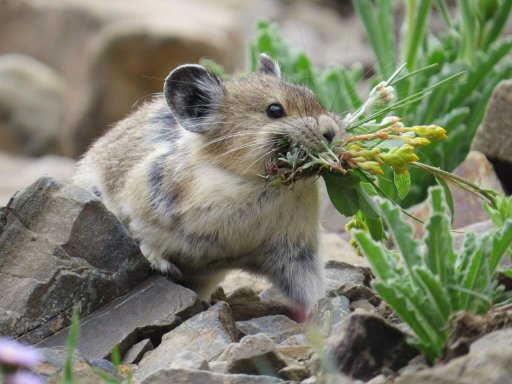How Or Why It's Used Methane Kid Images To Draw
This page will aid you understand the science behind climatic change, the impactsof a changing climate, andhow yous can help deadening climate alter and prepare for it.We've too created a list of resources and activities for educators and students of all ages.
The Scientific discipline
Science paints a clear pic: Climate change is happening; it is caused mostly past humans; and it creates many serious and damaging effects. The master cause of climate modify is human activities – like driving cars, creating electricity, and cut down forests – not natural changes in the climate. These human activities release gases into the atmosphere called greenhouse gases , which slowly warm the planet, creating climate change.
The climate is very circuitous, and there are still some things we don't know about it. But through centuries of studies and experiments, we've been able to create a potent understanding of how the system works, and how humans are irresolute it.
The Greenhouse Result
Imagine a greenhouse made of glass used to grow plants, like flowers and vegetables. The greenhouse keeps the plants inside warm fifty-fifty when it'south cold outside considering information technology traps heat from the sun. The earth's atmosphere acts similar a greenhouse: When light from the sun passes through the atmosphere, some of it is absorbed by the Earth'southward surface to estrus it, just some heat is also trapped in our temper by certain gases. These heat-trapping gases are called greenhouse gases, and they act similar a coating, keeping the earth warm. This greenhouse effect is a natural procedure that makes the planet comfortable to alive.
Only human activities are increasing the amount of greenhouse gases in our atmosphere. One blazon of greenhouse gas, carbon dioxide, has reached a level in our atmosphere that the Globe hasn't seen for more than 400,000 years! Plants, soils, and the bounding main can absorb carbon dioxide, but they tin't keep upwardly with all the actress greenhouse gases that we have been releasing. And some greenhouse gases stay in the atmosphere for a long time, from hundreds to fifty-fifty thousands of years. All these gases are making things hotter than natural, so we need to cease producing them to avoid climatic change.
The Greenhouse Effect Explained

Where do greenhouse gases come from?
Up until about 150 years ago, humans did not produce many greenhouse gases. That changed as the man population grew, we cut downwards forests to make fashion for cities and farms, and important inventions and engineering science, like in-home electricity and cars, transformed the manner we live.
These inventions and technologies demand energy. Some types of energy called fossil fuels — similar coal, oil, and natural gas — have become important sources of that energy. Burning fossil fuels releases carbon dioxide and other greenhouse gases into the atmosphere. We call the release of these gases emissions .
Today in the United States, electricity and transportation (cars, trucks, and planes) are responsible for virtually 60 percent of greenhouse gas emissions. The residue comes from agronomics, industry – such as factories that make products nosotros utilise – and from energy we use in our homes and businesses.
Learn more about U.South. greenhouse gas emissions here.
Greenhouse Gases
The almost common types of greenhouse gases are:
- Carbon Dioxide (CO 2 ): Carbon dioxide is the most common greenhouse gas created by human activities. It makes upward 80 percent of U.S. greenhouse gas emissions. Well-nigh carbon dioxide enters the atmosphere when fossil fuels (oil, natural gas, and coal) are burned for electricity and transportation, and because of other processes like making cement. Carbon dioxide is removed from the atmosphere and stored when it is absorbed by plants, soils, animals, and the ocean as part of the carbon bike.
Larn more than about how energy emissions are controlled in the Us.
- Methyl hydride (CH 4 ): Methane is the next most mutual greenhouse gas emitted by human activities. Information technology makes up 10 per centum of U.S. greenhouse gas emissions. Most marsh gas emissions come up from raising livestock (like cows), merely methane is besides released when coal, natural gas, and oil are produced and transported, and when organic waste (like food) decays in landfills. Methane is a stronger gas than carbon dioxide, meaning information technology creates more warming, but it stays in the atmosphere for a shorter time.
Acquire more than nigh how industrial greenhouse gases like methane are controlled in the U.s.a..
- Nitrous Oxide (Northward 2 O): Most nitrous oxide is emitted by agricultural activities, like applying fertilizer, but it also comes from industrial activities, burning fossil fuels, and other sources. It makes up six per centum of U.S. greenhouse emissions. Nitrous oxide is even more powerful than methyl hydride and carbon dioxide at warming the temper.
- Hydrofluorocarbons (HFCs), Perfluorocarbons (PFCs), and Sulfur Hexafluoride (SF6): Attempt proverb these gases three times fast! They're called "fluorinated gases" for short. These gases combined brand up just 3 percent of all U.S. greenhouse gas emissions. That may audio pocket-sized, but they are very important to solving climate change because they stay in the atmosphere for a very long time (sometimes for thousands of years!) and are much more powerful warmers than all other gases. These gases are made by humans and are used to cool our refrigerators, freezers, buildings and cars.
U.Due south. Greenhouse Gases by Gas Type and Sector, 2022

Impacts of a Changing Climate
Considering of increases in greenhouse gas emissions, global temperatures are rising. Each of the by four decades has been warmer than the previous i. 2022 and 2022 were the warmest years on record, and the six warmest years accept all been since 2022.
Larn more almost the relationship between extreme weather and climate change.
The following charts show how emissions and temperatures have gone up since 1900, and how they could continue to change in the future. If we continue to emit more than and more greenhouse gases, the temperature of the Globe will ascent a lot – maybe as much every bit 5 degrees Celsius (9 degrees Fahrenheit) by 2100. Even if we reduce our emissions right at present, the temperature of the Globe will still rise slightly, but we might be able to keep the rise below 2 degrees Celsius (or near 4.8 degrees Fahrenheit). Two degrees might not sound similar much, but scientists hold that fifty-fifty that small corporeality of warming can accept large impacts on humans and the environment.
Past and Projected Changes in Carbon Emissions and Temperature

Rising global temperatures bear on many things, like extreme weather, human health, food supply, and ecosystems. These impacts are already being felt today, and groups similar the poor, elderly, and others are peculiarly vulnerable.
Impacts of climatic change include:
- Heat waves. Heat waves are long periods of time with temperatures that are hotter than normal. Equally the Earth warms, more than areas volition be at risk for hotter and more mutual farthermost estrus waves. Learn more than almost the link between climate change and extreme rut.
- Heavy precipitation and storms. Heavy atmospheric precipitation – like rain or snowfall – is becoming more common in many locations, which tin can lead to flooding and other dangerous weather. As seas warm, littoral storms like hurricanes are likewise becoming more than frequent and damaging. Learn more than well-nigh the link betwixt climatic change and heavy precipitation and hurricanes.
- Sea level rise. Sea levels have risen about 8 inches since 1880 because glaciers and ice sheets are melting and seas are warming. Scientists predict that, with one.v degrees Celsius of warming, sea levels could rise by every bit much every bit i.8 feet this century, which would harm communities living on islands and near coasts. These rises could be even higher if glaciers in Greenland or Antarctica melt very speedily.
- Threats to habitats and animals. Warming temperatures, rising seas, melting ice, and other impacts of climate change tin threaten the habitat of many plants and animals. Some species are moving to new habitats, but others may struggle to suit and get endangered or extinct.
- Ocean acidification. Extra carbon dioxide in the temper is absorbed by the oceans, making them more acidic. This can brand it difficult for corals and organisms that class shells to survive, which tin create problems in the food concatenation for other ocean animals.
- Wildfires. These are fires that burn large amounts of forests and castor. When they are not controlled, wildfires can destroy homes and be mortiferous. The number of big wildfires and the length of the season when they're most likely and threatening have been increasing in contempo years. Discover out how climate change will worsen wildfire conditions.
- Drought. A drought is a menstruation with fiddling rain and not enough water. Global warming volition increment the risk of drought in some places and make it harder to abound nutrient. Acquire about the links between climatic change and drought.

How can you help?
Even though climatic change sounds scary, we withal accept fourth dimension to avoid some of the worst impacts. Everyone can play a part, including government, businesses, and you.
At that place are two main things we need to do:
The first is to reduce the greenhouse gas emissions responsible for climate modify. By choosing cleaner means to power our homes, offices, and cars, and being more efficient and less wasteful, we can produce fewer greenhouse gas emissions.
At that place are lot of things you tin exercise to aid, like turning off the lights when you leave a room to reduce the electricity you use, walking or biking where yous tin, or planting copse to absorb carbon dioxide. If you lot do any of these things, make sure yous communicate with other people (like your family, teachers, and friends) about why you're doing them! Advice can inspire more than people to change their habits and help save the climate.
Await for more ideas on what nosotros can exercise together and individually.
The second is to prepare for life in a changing climate. Fifty-fifty if we could stop creating greenhouse gases tomorrow, the climate would still change some because of our past emissions. And then we need to make sure our buildings, roads, businesses, and communities are fix for the climate changes that we can't avoid. This includes things like helping cities on the coast set for floods, preventing wildfires in our forests, and more than.
Learn how communities and companies are preparing.
The power of YOUth
Around the world, young people are learning virtually climate change and taking action. In fact, young people are some of the most important voices in the climate movement considering you tin can inspire powerful people to create a better future for yous.
You don't have to be a rocket scientist or a politician to brand a difference in the fight against climatic change. Whatever your talents are, there'southward a office for you to play. Some young people, like Greta Thunberg, Vanessa Nakate, and others, are leading the Fridays for Future movement to tell their governments to create strong policies to fight climate change. Other students are inventing new technologies to cutting emissions and reduce waste. And others are using their creativity to bring sensation to climatic change by writing music and creating fine art.
Yous can likewise look for ways to go involved in your community – maybe you can help your school fix upwardly a composting program to continue food waste product out of the landfill. Mayhap your synagogue or mosque needs help switching to free energy efficient lights. Maybe you can write a letter to your local government to encourage your community to prepare for extreme weather or wildfires. Everyone can do something to fight climatic change.
Check out ourEducator Resources page for activities yous tin can do to larn more about how climatic change works and how you can be a function of the solution.
C2ES thank you the Alcoa Foundation for its support, which allowed us to develop our Climate Classroom content. Every bit a fully independent arrangement, C2ES is solely responsible for its positions, programs, and publications.
Source: https://www.c2es.org/content/climate-basics-for-kids/
Posted by: berryhalseara.blogspot.com


0 Response to "How Or Why It's Used Methane Kid Images To Draw"
Post a Comment